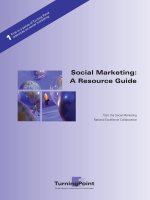SOCIAL MARKETING
Bạn đang xem bản rút gọn của tài liệu. Xem và tải ngay bản đầy đủ của tài liệu tại đây (390.57 KB, 27 trang )
SOCIAL MARKETING
MARKETING - DEFINITION
• A management orientation that accepts
that the key task of the system is to
determine the wants, needs and values of
a target market and shape the system in
such a manner to deliver the desired level
of satisfaction.
Social Marketing - Definition
• Social marketing is the use of marketing
principles to influence human behavior in
order to improve health and/or benefit
society.
• It is also used to mobilize public support
for core public health policies and
institutions.
Marketing Process
• Marketing begins with existing or potential
consumer needs plans for a coordinated
set of programs and services and
achieves its goals through creating
consumer satisfaction.
• The service fits the consumer and sells
itself is the “ideal type” marketing concept
Comparison of Marketing and
Selling
Selling Concept
Focus – the product
Method – public relations,
education
Marketing Concept
Focus – consumer
satisfaction
Method – data driven
consumer preference
Outcome – increased use
of services (revenues)
through increased
usage
Outcome – increased use
of services (revenues)
through consumer
satisfaction
Marketing Questions
•
•
•
•
•
What are we marketing
To whom are we marketing it?
How are we marketing it?
Where are we marketing it?
When are we marketing it?
KEY MARKETING CONCEPTS
• Exchange relationships – give something
in order to get something in return.
– Based on social cognitive theory of outcome
expectancies. “if all other things are equal a
person will choose to perform an activity that
maximizes a positive outcome or minimizes a
negative outcome.” (Kotler & Andreason)
– Only costs and benefits important to the
person contemplating the exchange matter.
2
• Behavior Change - The bottom line of all
marketing strategy.
– Changing ideas should lead to changing
behavior.
– Example – national 5 a day campaign
targeted audience to add 2 servings of fruits &
vegetables.
3
• Competition – anything that limits
resources, diverts attention from the
subject of the initiative or calls for contrary
behaviors. (Siegel & Donor, 1998)
– Sources of competition include;
• Other organizations conducting programs on the
same subject
• Other programs emphasizing behavior change
• Commercial sources
4
• Consumer orientation – approaches are
selected and implemented based on what
is most relevant and potentially effective
with the target, not what experts believe to
be important to the target population.
(Lefevbre, 1995)
The 4 P’s of Marketing
• Product – the desired change you are asking of
your audience and the associated benefits,
objects and services that support the change
• Price – the cost or barriers the target audience
faces in making the desired change
• Place – where/perform behavior, access
products or services.
• Promotion – communications, messages,
materials, channels and activities that will
effectively reach your audience.
PRODUCT
• What are the benefits of the behavior
change?
• What is the competition?
• What legal, technological and/or economic
policy changes can facilitate individual
behavior change?
• What accomplishments can be expected
without policy changes?
PRICE
• What will the behavior change cost each
target audience?
• Is there a fair exchange for the benefit
they associate with the behavior change?
• How can costs be minimized?
PLACE
• What are the target audiences perception
of place?
• What barriers (costs) does the place
create, and how can they be overcome?
PROMOTION
• What is the current demand among the
target audience for behavior change?
• What messages can best influence
demand?
• What promotional materials & activities are
appropriate for the message?
• How can the material & activities best be
delivered to the target audience
members?
PARTNERS
• What other organizations are conducting
activities addressing the social change?
• What organizations are credible to the
target audience?
• What are the opportunities to work
together with either type of organization?
POLICY
• What policy changes are necessary for
individuals to improve their health
behaviors?
• What policy changes could support
individuals in their efforts to improve their
health behaviors?
• What policy changes can this organization
bring about?
SIMPLE IDEAS
DRAWN FROM SOCIAL COGNITIVIE THEORY
• FUN – Provide perceived benefits the
audience cares about
• EASY – remove barriers to action; make
behavior as simple & accessible as
possible.
• POPULAR – Influence social norms; help
the audience feel that this is something
others are doing, particularly those who
are important to them.
Social Marketing
• Understand your audience
• Be clear what you want your audience to
do.
• Understand exchange – Offer something
appealing in return for changing behavior
• Competition
• Apply 4 “P’s” plus 2
• Understand how policies, laws and rules
affect social or behavioral change.
Phases of Social Marketing
• Describe the Problem – behavioral focus
• Conduct Market Research –
segmentation, competing behaviors,
benefits and barriers,
• Create marketing strategy
• Plan the intervention
• Plan monitoring and evaluation
• Implement the intervention and evaluation
MARKET SEGMENTATION
• Primary markets are those considered
central to an organizations
achievement of its mission.
• Secondary Markets are important but
not essential.
TYPES OF MARKETS
•
•
•
•
Consumer
Partner
Supplier
Markets that are segmented by function
o Prevention - primary secondary tertiary
o Government relations, philanthropy ,
research, education
o Demographic characteristics
MARKET POSITIONING
• Choosing who are consumers and
other publics
• What position in the market do you
take?
COMMUNICATION STRATEGY
• Who should be the target audience and what are
they like?
• What is the action they should take – what are
they doing now?
• What are the obstacles that stand between the
audience and the desired behavior?
• What is the benefit to the audience of engaging
in the behavior?
• What is the support for that benefit – what will
make it credible to the audience?
2
• What are the best openings for reaching
the audience – are the channels available
appropriate for conveying the message?
• What image should the communications
convey?









